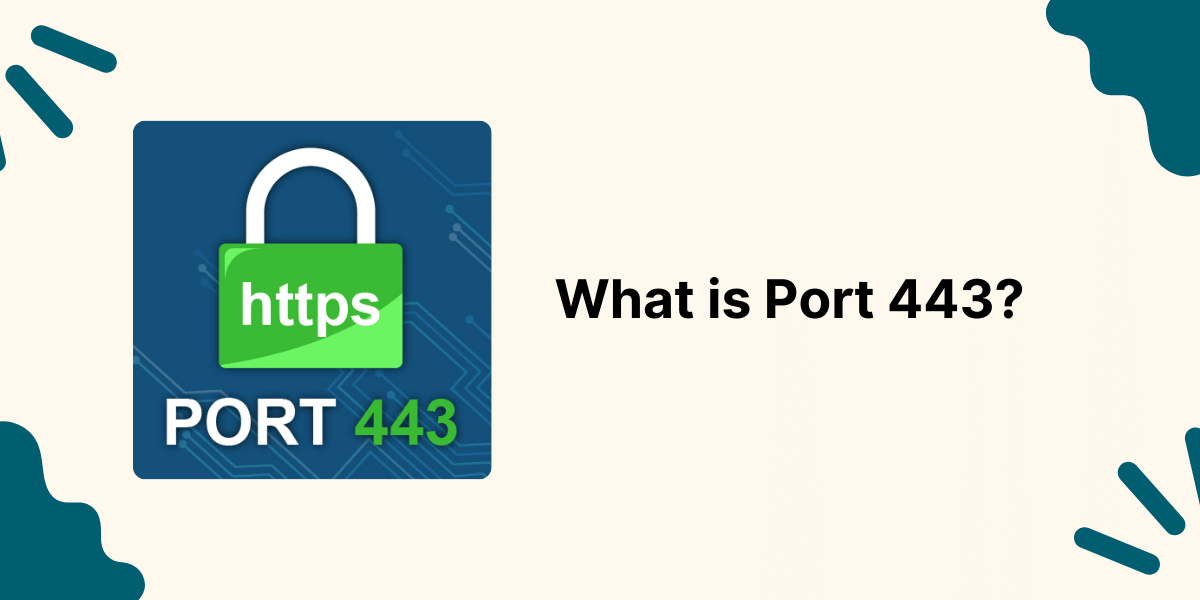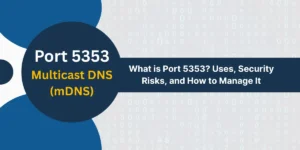What Is Port 110?
Port 110 is a 16-bit TCP and UDP port number used by internet applications to identify specific services and protocols. It is one of the standard registered port numbers defined by the Internet Assigned Numbers Authority (IANA) for use with the TCP/IP protocol.
The TCP/IP model relies on ports for determining destinations for network traffic. They enable distinguishing between multiple concurrent connections on the same network device. Port numbers range from 0 to 65535, split into three different categories:
Port 110 has officially been registered for the Post Office Protocol version 3 (POP3). It is designated as a well-known, privileged port that requires root access to open on most systems.
Key Takeaways
- Port 110 is primarily used for Post Office Protocol version 3 (POP3), an email retrieval protocol.
- It establishes a connection between email client software and a mail server for downloading messages to a local computer.
- Port 110 uses Transmission Control Protocol (TCP) for reliable data transfer.
- It is considered an insecure port and should only be used with encrypted connections like POP3S.
- Other common uses include malware infections and unofficial alternate ports for services.
- Firewalls often block port 110 traffic for security purposes.
- Understanding port 110 is critical for configuring email clients, allowing legitimate traffic, and troubleshooting connectivity issues.
What is Port 110 Used For?
The primary use of port 110 is to facilitate POP3 email connections.
- POP3
- Malware and Viruses
- Unofficial and Non-Standard Uses
POP3
POP3 (Post Office Protocol version 3) is a standard application-layer internet protocol used by email clients to retrieve email from remote mail servers over a TCP/IP network. It enables downloading and storing email messages locally on a user’s computer or device.
Here’s an overview of how POP3 uses port 110:
- The client opens a connection to the POP3 server on port 110.
- The server sends a greeting and requests authentication.
- The client sends authentication credentials (usually username and password).
- If the credentials are valid, the connection switches to “transaction” mode for retrieving messages.
- The client can then use POP3 commands like LIST, RETR, DELE, etc., to get mail headers, download messages, delete messages on the server, and more.
- When the client finishes retrieving messages, it sends the QUIT command to terminate the session.
Malware and Viruses
Unfortunately, port 110 has also become commonly associated with malware and viruses over the years. Various worms and trojans leverage vulnerabilities in outdated versions of POP3 software to spread.
Some examples of well-known malware that has exploited port 110 include:
- Sasser Worm
- Nimda Virus
- BadTrans Worm
- PopRoP Worm
Modern malware threats continue to exploit port 110 due to its ubiquitous use for email access. Attackers use it as a vector to infect machines and create botnets.
For this reason, many organizations block port 110 at the network perimeter if it is optional. However, this can cause issues with legitimate email usage in some cases.
Unofficial and Non-Standard Uses
A few other uncommon uses of port 110 include:
- Some games and non-standard applications use it as an alternate port for game traffic or communication.
- Small mail server products or niche email systems occasionally use it for non-standard mail transfer protocols.
- Qnext SMS service uses port 110 for its client application.
- A few remote administration tools use it for server communications.
How Does Port 110 Work?
Port 110 relies on the TCP network protocol to transfer data reliably.
Some key points about how it works:
- TCP ensures messages sent between clients and servers are received in the correct order and without errors. If packets are corrupted or dropped, TCP automatically resends them.
- It establishes persistent connections between endpoints to enable communication sessions. This differs from UDP, which is connectionless.
- TCP has built-in congestion and flow control mechanisms to adjust network traffic dynamically. This prevents overloading connections.
- Port 110 utilizes TCP’s reliable transfer and connection abilities to exchange POP3 commands and email message data.
- The POP3 client initiates a TCP handshake to the server on port 110 to set up the session.
- The connection remains open during the client’s authentication and email retrieval steps.
- TCP ensures all POP3 commands are received, and email message downloads are complete.
Key Facts About Port 110
Here are some additional pertinent facts about port 110 that are useful for network administrators and engineers:
- Port 110 is officially registered with the IANA and marked as a well-known port.
- It uses TCP as its core transport protocol rather than UDP.
- The official service name associated with the port is POP3.
- It is categorized under the Application layer of the TCP/IP model.
- By convention, server-side software will listen on port 110 for client connection requests.
- On Unix-style operating systems, only the root user can open ports below 1024, like 110, due to the privileges required.
- The /etc/services file on systems maps port 110 to “pop3” for reference by network services.
- POP3 software utilizes port 110 traffic to authenticate clients and transmit email data.
- Port 110 is considered a cleartext, insecure protocol since POP3 traffic is unencrypted.
- Secure variants like POP3S use SSL/TLS encryption over port 995 instead to secure connections.
- Firewalls often block port 110 by default, requiring explicit rules to allow POP3 traffic.
Port 110 vs. Other Email Ports
With so many port numbers associated with email services, it cannot be very clear. How does port 110 relate?
- Port 25: Default port for SMTP (email submission) traffic. Used for sending outgoing messages to mail servers.
- Port 143: Used for IMAP4 protocol. Similar to POP3 but keeps messages on the server.
- Port 995: Secure POP3S traffic that uses SSL/TLS encryption.
- Port 465: SMTP over SSL/TLS for sending encrypted email.
- Port 993: Secure IMAP4 over SSL/TLS encryption.
Security with Port 110
Since port 110 utilizes an insecure protocol without encryption, proper security measures should be taken:
- Use VPNs or SSL/TLS: Encrypt traffic for port 110 by routing it through VPN connections or using POP3S rather than plain POP3.
- Require Authentication: Do not allow anonymous POP3 access on your mail server. Require username and password login.
- Limit Access: Only allow port 110 connections from specific trusted IP addresses or networks that require it.
- Disable When Not In Use: If POP3 functionality isn’t needed regularly, disable the port 110 listener.
- Patch Frequently: Keep POP3 software like mail servers updated to prevent exploits of vulnerabilities.
- Use Firewalls: Set up firewall policies to block port 110 except where explicitly needed.
- Monitor Activity: Watch port 110 connections in logs for patterns indicative of malware or unauthorized use.
Troubleshooting Issues of Port 110
If you are having problems connecting to a POP3 server or getting emails via port 110, here are some troubleshooting steps:
- Verify port 110 is actually open on your network. Use a port scanner tool and check firewall policies.
- Double check the POP3 server name/IP and login credentials are entered correctly in your email client.
- Try telnetting directly to port 110 on the server to test basic connectivity.
- Check for proxy/NAT issues that could block port 110 packets. Disable proxies temporarily to test.
- Temporarily disable any host-based antivirus/security software that could be blocking port 110.
- Verify encryption options are configured consistently on both the client and server sides.
- Inspect packet captures to check if port 110 traffic is reaching the server or getting dropped/blocked somewhere along the path.
- Review server and client application logs for helpful errors relating to port 110 connections.
- If problems persist, contact your email service provider, networking team, or software vendors for assistance.
Final Thoughts
Port 110 plays a vital role in email infrastructure by enabling POP3 clients to retrieve messages from servers. This common yet unsecured port requires thoughtful security policies, encryption, authentication, and firewall rules to prevent exploitation. While POP3 still maintains relevance, the continued adoption of modern protocols like IMAP and SMTP over TLS highlights the growing need for encrypted alternatives.
As networking evolves, port 110 will likely persist, given its ubiquity. However, progressively securing and restricting its use points toward a future where ports like 110 may become obsolete. Understanding key facts about essential ports like 110 allows IT teams to architect robust solutions tailored to their specific email needs.
Frequently Asked Questions About Port 110
What is port 110 used for?
Port 110 is primarily used by the Post Office Protocol version 3 (POP3) to allow email client applications to retrieve mail from servers over TCP/IP networks. It also facilitates the downloading of messages to users’ local computers.
Is port 110 TCP or UDP?
Port 110 exclusively uses the TCP transport protocol. TCP ensures reliable, ordered data delivery between port 110 endpoints.
Is port 110 secure?
No, plain POP3 over port 110 is an insecure, cleartext protocol. Since it is unencrypted, traffic can be intercepted. POP3S over TLS on port 995 should be used for secure POP3 access.
Why is port 110 blocked?
Many organizations block port 110 due to its use of insecure POP3. Additionally, malware and viruses often exploit vulnerabilities with outdated POP3 software listening on port 110. Preventative blocking helps improve security posture.
What is the difference between port 110 and port 25?
Port 25 is used for SMTP (sending email), while port 110 is used for POP3 (retrieving email). Port 25 accepts outbound messages from clients and forwards them on, while port 110 lets clients download messages to their local system.
Can port 110 be used for SMTP?
No, port 110 is only officially registered for POP3 usage. SMTP is designed to operate over port 25 by default or port 465 if using SMTPS (SMTP over SSL).
How do I open port 110?
You’ll need to create firewall/security group rules to allow inbound connections on port 110 and ensure any host-based firewall on the system also permits port 110 traffic. Additionally, the POP3 service needs to be installed and actively listening on the port.
What can use port 110 besides POP3?
Some other uncommon uses of port 110 include games/chat services using it for communications, remote administration tools, SMS services, and malware infections exploiting vulnerable POP3 software on the port.
Is POP3 required for email anymore?
While POP3 is still widely supported, many modern mail clients and providers are transitioning to IMAP for improved syncing, folders, search, and message retention on the server. POP3 is no longer mandatory for business email in most cases.

Priya Mervana
 Verified Web Security Experts
Verified Web Security Experts
Priya Mervana is working at SSLInsights.com as a web security expert with over 10 years of experience writing about encryption, SSL certificates, and online privacy. She aims to make complex security topics easily understandable for everyday internet users.



